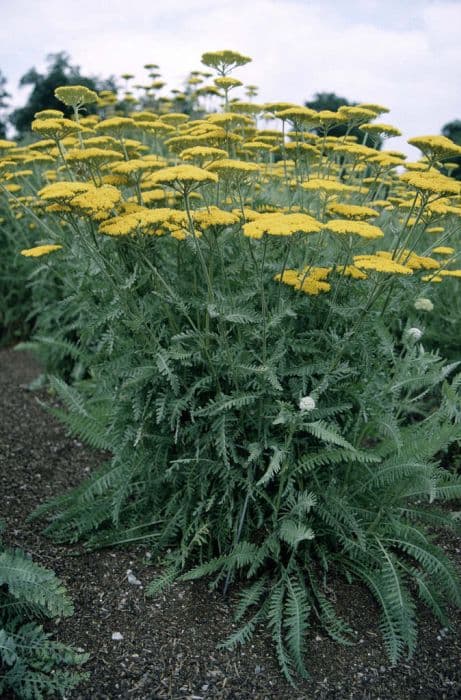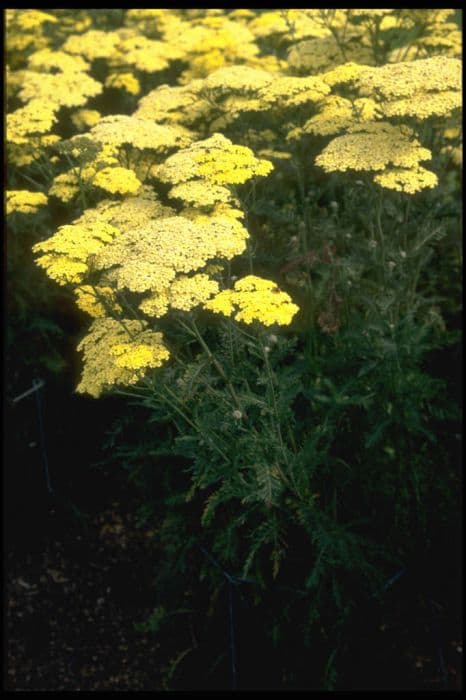Blazing star Liatris spicata 'Floristan Weiss'
ABOUT
The Liatris spicata 'Floristan Weiss', commonly known as Blazing Star or Gayfeather, is a herbaceous perennial plant with a striking and elegant appearance. Its most distinctive feature is the tall, dense spikes of flowers that emerge in the summer. These flower spikes are made up of numerous small, fluffy, white flowers that bloom progressively from the top down. This provides a unique look as the topmost flowers fade while the ones below are just opening, creating a gradient effect along the spike. The foliage of the Blazing Star consists of narrow, grass-like leaves that are medium to dark green in color. They are arranged in a tuft at the base of the plant and also alternate up the stems, becoming smaller as they ascend. The leaves' texture adds to the feathery appearance of the overall plant. The contrast between the white flower spikes and the green foliage is visually striking, and the plant is often used in gardens and landscaping for its vertical interest and ability to attract butterflies. The Blazing Star also looks spectacular when planted in groups, where the repetition of its flower spikes can create a dramatic effect. Moreover, due to its color and form, it can be a versatile addition to a variety of garden designs, pairing well with both bold and soft-colored plants.
About this plant
 Names
NamesFamily
Asteraceae
Synonyms
Dense Blazing Star, Spike Gayfeather, Marsh Blazing Star
Common names
Liatris spicata 'Floristan Weiss'.
 Toxicity
ToxicityTo humans
The plant commonly known as Blazing Star is not generally considered toxic to humans. There are no well-documented cases of poisoning or adverse reactions from ingesting parts of the Blazing Star plant. However, it is generally advised not to eat ornamental plants because of the uncertainty of their effects and potential for pesticide contamination.
To pets
Blazing Star is also not known to be toxic to pets. Dogs, cats, and other domestic animals can come into contact with this plant without expected issues regarding poisoning. Therefore, if a pet ingests part of a Blazing Star plant, they are unlikely to show any symptoms of poisoning or suffer toxic consequences from the plant matter itself. However, it is always best to prevent pets from eating plants to avoid any potential gastrointestinal upset or unforeseen reactions.
 Characteristics
CharacteristicsLife cycle
Perennials
Foliage type
Deciduous
Color of leaves
Green
Flower color
White
Height
2-4 feet (60-120 cm)
Spread
1-2 feet (30-60 cm)
Plant type
Herb
Hardiness zones
3-9
Native area
North America
Benefits
 General Benefits
General Benefits- Attracts pollinators – Liatris spicata 'Floristan Weiss', commonly known as Blazing Star, is known for attracting bees, butterflies, and other beneficial pollinators to the garden.
- Drought tolerant – Once established, Blazing Star is quite drought-resistant, making it a good choice for water-wise gardens.
- Ease of care – This plant is low maintenance, requiring minimal care once it is established in the right conditions.
- Long blooming period – Blazing Star offers a lengthy blooming period, often from mid-summer to early fall, providing extended garden interest.
- Vertical accent – The tall, spiky flowers add vertical interest to garden beds and borders, which can be especially valuable in designing aesthetic garden layouts.
- Deer resistant – Blazing Star is generally resistant to deer, making it a good choice for gardens in areas where deer browse.
- Native plant – As a plant native to North America, it supports local ecosystems and is well-adapted to regional climates and soils.
- Cut flower – The long, showy spikes of Blazing Star make excellent cut flowers for arrangements with a good vase life.
 Medical Properties
Medical PropertiesThis plant is not used for medical purposes.
 Air-purifying Qualities
Air-purifying QualitiesThis plant is not specifically known for air purifying qualities.
 Other Uses
Other Uses- Liatris spicata 'Floristan Weiss', commonly known as Blazing Star, can serve as a striking focal point in dried floral arrangements due to its tall and fluffy flower spikes which maintain their shape and color after drying.
- Blazing Star is used in butterfly gardens because it is a known attractant for butterflies, providing a nectar source and encouraging pollinator biodiversity within the garden environment.
- This plant's vertical growth habit can be used to add architectural interest to garden designs, playing off against lower-growing, mound-forming plants to create dynamic visual contrasts.
- In educational gardens, Blazing Star is used to illustrate plant survival strategies such as corm growth and drought resistance, making it a practical example for teaching botany and horticulture.
- Artists and botanical illustrators may use Blazing Star as a subject for drawings and paintings, capturing its unique shape and the intricate detail of its florets.
- Bird lovers might plant Blazing Star to attract goldfinches and other seed-eating birds, which are enticed by the seeds post-bloom in the late season.
- Blazing Star can be used in sensory gardens due to its interesting texture, which provides a tactile experience for visitors to feel and interact with.
- Photographers utilize Blazing Star as a backdrop for portraits and nature photography, where its vivid color and vertical lines can enhance the composition of their shots.
- Because Blazing Star blooms sequentially from top to bottom, it can be used as a living timeline or calendar, marking the progression of summer into fall in the garden.
- In landscape restoration projects, Blazing Star is included as a native plant species to help restore natural ecosystems and provide habitat for local wildlife.
Interesting Facts
 Feng Shui
Feng ShuiThe Blazing Star is not used in Feng Shui practice.
 Zodiac Sign Compitability
Zodiac Sign CompitabilityThe Blazing Star is not used in astrology practice.
 Plant Symbolism
Plant Symbolism- Independence: Liatris, also known as Gayfeather, is a plant that can tolerate dry conditions and often symbolizes independence due to its ability to stand tall and proud without needing much care.
- Attraction: With its striking appearance and ability to attract butterflies, the Gayfeather plant often represents an attraction or magnetism to both people and other creatures in nature.
- Pride: The Gayfeather has a stately and upright form, contributing to its association with pride and high standing.
- Joy: The bright and showy spires of the Gayfeather flowers bring joy and happiness, making it a symbol for cheerfulness and positive energy.
 Water
WaterThe Blazing Star, needs to be watered regularly, especially during the growing season, but ensuring the soil is not waterlogged. Allow the soil to dry between waterings, typically watering once a week, depending on climate conditions. In general, providing about one gallon of water per week is suitable for an established plant, but young plants may need slightly more frequent watering until they are well-rooted. Be sure to water deeply to encourage deep root growth, which will help the plant become more drought-tolerant as it matures.
 Light
LightThe Blazing Star thrives in full sunlight, requiring at least six hours of direct sun daily to bloom optimally. It should be placed in a spot where it can enjoy uninterrupted sunlight, though some light afternoon shade can be tolerated, especially in hotter regions. Do not place it in full shade as that could impede its growth and reduce flowering.
 Temperature
TemperatureBlazing Star prefers temperatures between 60 to 75 degrees Fahrenheit but can survive lower temperatures down to about 20 degrees Fahrenheit. During the growing season, keeping within the ideal range encourages blooming, while during dormancy in winter, it can withstand colder temperatures. Ensure not to expose the plant to temperatures above 85 degrees Fahrenheit for extended periods, as this may cause stress.
 Pruning
PruningPruning Blazing Star involves cutting back the flower stalks after blooming to tidy the plant and potentially encourage a second flush of flowers. It's best to prune in late summer or early fall, following the plant's bloom cycle. Deadheading spent flowers can also be done periodically throughout the blooming season to maintain aesthetics and plant health.
 Cleaning
CleaningAs needed
 Soil
SoilThe ideal soil mix for Blazing Star should be well-draining, with a mix of loam, sand, and peat or compost to retain some moisture. A slightly acidic to neutral pH of 6.0 to 7.0 is preferred for optimal growth.
 Repotting
RepottingBlazing Star typically does not need frequent repotting; repot it every 2 to 3 years or when the plant outgrows its container.
 Humidity & Misting
Humidity & MistingBlazing Star thrives in average humidity conditions and does not require any special humidity adjustments.
 Suitable locations
Suitable locationsIndoor
Place in well-lit area; ensure well-draining soil.
Outdoor
Plant in full sun, well-drained soil, and divide every few years.
Hardiness zone
3-9 USDA
 Life cycle
Life cycleLiatris spicata 'Floristan Weiss', commonly known as Blazing Star or Gayfeather, begins its life as a dormant corm that sprouts in early spring, producing grass-like foliage. As the plant matures, it develops tall, erect flowering spikes typically during the summer, with fluffy, white, tuft-like flowers that bloom from the top down. After the flowering period, the plant sets seed, which can be dispersed by wind or wildlife for propagation. Throughout the growing season, the plant accumulates and stores energy in its corm for the next year. As autumn arrives, the foliage begins to wither, and the plant enters a period of dormancy over the winter. With the return of favorable conditions in spring, the cycle recommences with the corm sending up new growth.
 Propogation
PropogationPropogation time
Summer to Fall
The most popular method of propagating Liatris spicata 'Floristan Weiss', commonly known as Blazing Star, is by division. The best time to divide this perennial is in early spring or fall. Gardeners should carefully dig up the clumps and separate them into smaller clumps, ensuring that each new clump has at least two or three growth points. These new clumps can then be replanted into well-draining soil at the same depth they were growing previously. It is important to water the newly planted divisions thoroughly to help establish them. This propagation technique allows the plant to rejuvenate and can help to maintain its vigor and flowering performance.









